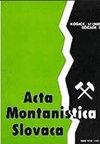稳定同位素示踪法研究巴厘岛登巴萨无承压含水层地下水来源
IF 1.4
4区 地球科学
Q2 GEOSCIENCES, MULTIDISCIPLINARY
引用次数: 1
摘要
地下水在多种用途的供水中发挥着重要作用,因此地下水的使用也必须注意资源本身的平衡和保护。了解地下水的来源和含水层的补给区对于确定保护模型至关重要。本研究的目的是确定登巴萨气象水位线(DMWL)、补给区和登巴萨无侧限含水层的地下水来源。采用有目的的采样方法确定雨水样本和地下水样本的数量和位置。在登巴萨地区的几个地点共采集了5个雨水样本和18个地下水样本。用Picarro L2130-i激光光谱法测定了δ18O和δ2H的稳定同位素。研究表明登巴萨LMWL为δD=8.5839xδ18O+19.876;从氧-18同位素的分布来看,低18O值主要分布在北部和东北部地区,因此可以将该地区划定为潜在的补给区;根据同位素比值,登巴萨无侧限含水层的地下水可分为三个成因组:(a)地下水成因a和B组代表直接降雨和局部补给的地下水系统,δ18O和δ2H同位素比值较低(贫化)至中等,具有高(富集)δ18O和δ2H同位素比率的δ18O位于DMWL的斜坡下方。本文章由计算机程序翻译,如有差异,请以英文原文为准。
The Stable Isotopes Approach as Tracers to Investigate the Origin of Groundwater In The Unconfined Aquifer of Denpasar, Bali
Groundwater plays an elemental role in the supply of water for numerous purposes, so the use of groundwater must also pay attention to the balance and preservation of the resource itself. Knowing the origin of the groundwater and the recharge area on an aquifer is essential to determine the conservation model. The purpose of this research is to determine the Denpasar Meteoric Water Line (DMWL), the recharge area, and the origin of groundwater in the unconfined aquifer of Denpasar. The determination of the number and location of samples, both rainwater samples, and groundwater samples, using a purposive sampling approach. A total of 5 samples of rainwater and 18 samples of groundwater were taken at several locations in the Denpasar area. The stable isotopes of δ18O and δ2H were carried out using laser spectrometry Picarro L2130-i. This research shows the Denpasar LMWL is δD = 8.5839 x δ18O + 19.876; from the distribution of oxygen-18 isotope, the low 18O value is dominated in the North and Northeast areas, so here this area can be delineated as the potential recharge area; and based on the isotope ratio, groundwater in the unconfined aquifer of Denpasar can be divided into three geneses groups: (a) Groundwater Genesis-A and B groups represent groundwater systems that come from direct rainfall as well as local recharge with low (depleted) to moderate δ18O and δ2H isotope ratios and groundwater groups Genesis-C, which has high (enriched) δ18O and δ2H isotope ratios, is located below the slope of the DMWL.
求助全文
通过发布文献求助,成功后即可免费获取论文全文。
去求助
来源期刊

Acta Montanistica Slovaca
地学-地球科学综合
CiteScore
3.60
自引率
12.50%
发文量
60
审稿时长
30 weeks
期刊介绍:
Acta Montanistica Slovaca publishes high quality articles on basic and applied research in the following fields:
geology and geological survey;
mining;
Earth resources;
underground engineering and geotechnics;
mining mechanization, mining transport, deep hole drilling;
ecotechnology and mineralurgy;
process control, automation and applied informatics in raw materials extraction, utilization and processing;
other similar fields.
Acta Montanistica Slovaca is the only scientific journal of this kind in Central, Eastern and South Eastern Europe.
The submitted manuscripts should contribute significantly to the international literature, even if the focus can be regional. Manuscripts should cite the extant and relevant international literature, should clearly state what the wider contribution is (e.g. a novel discovery, application of a new technique or methodology, application of an existing methodology to a new problem), and should discuss the importance of the work in the international context.
 求助内容:
求助内容: 应助结果提醒方式:
应助结果提醒方式:


